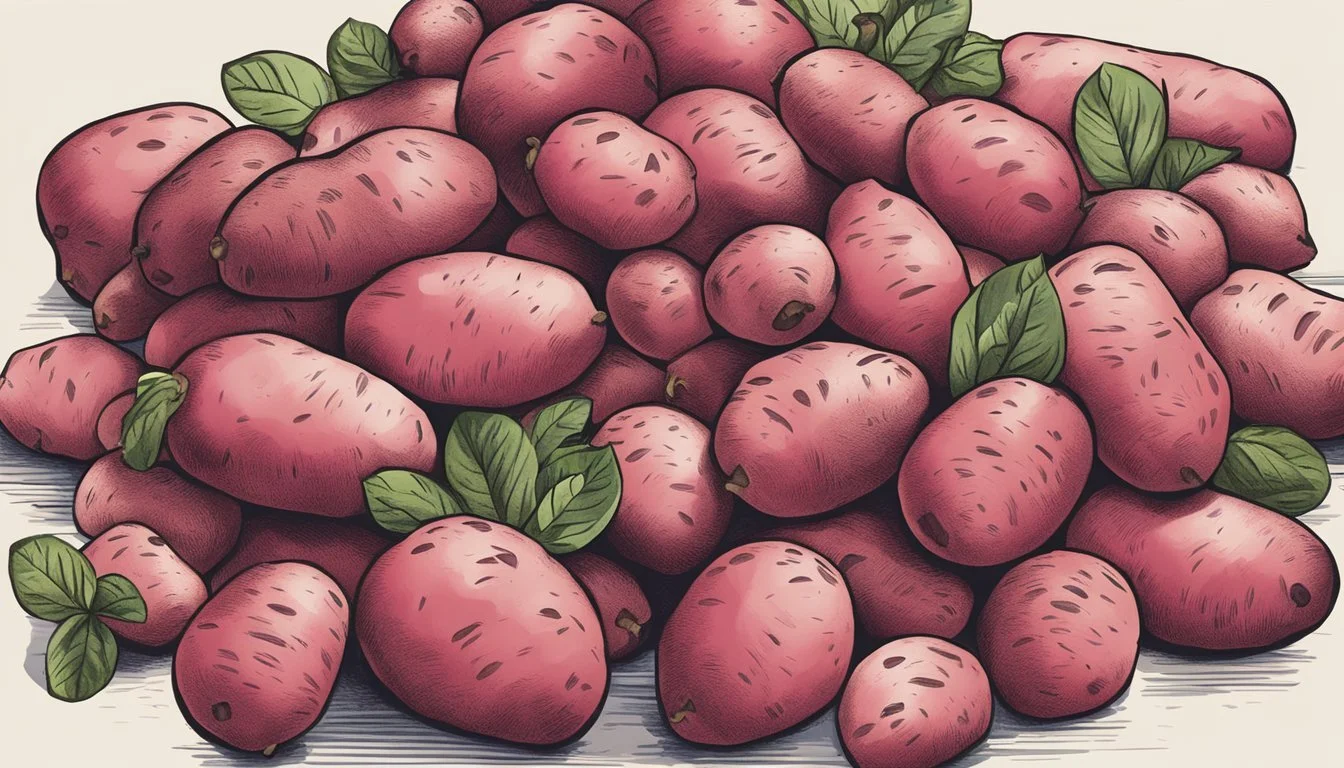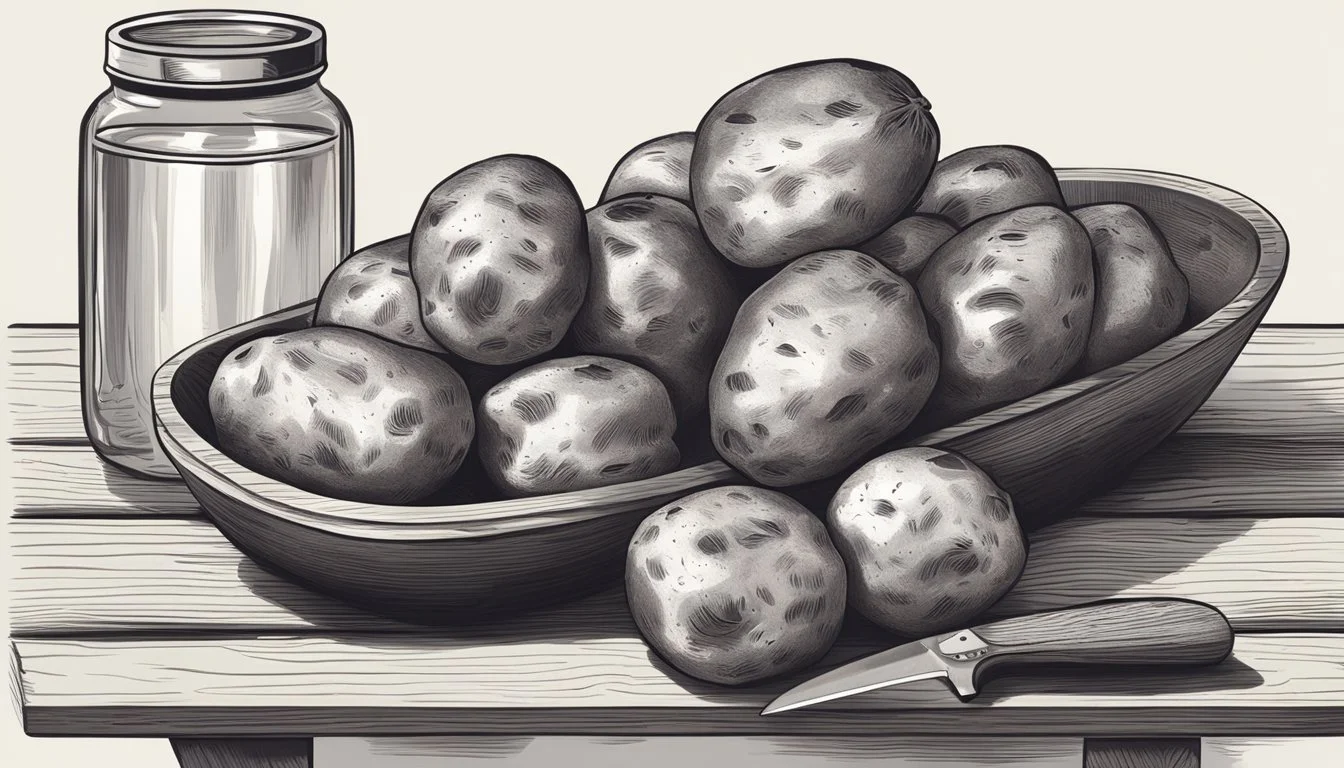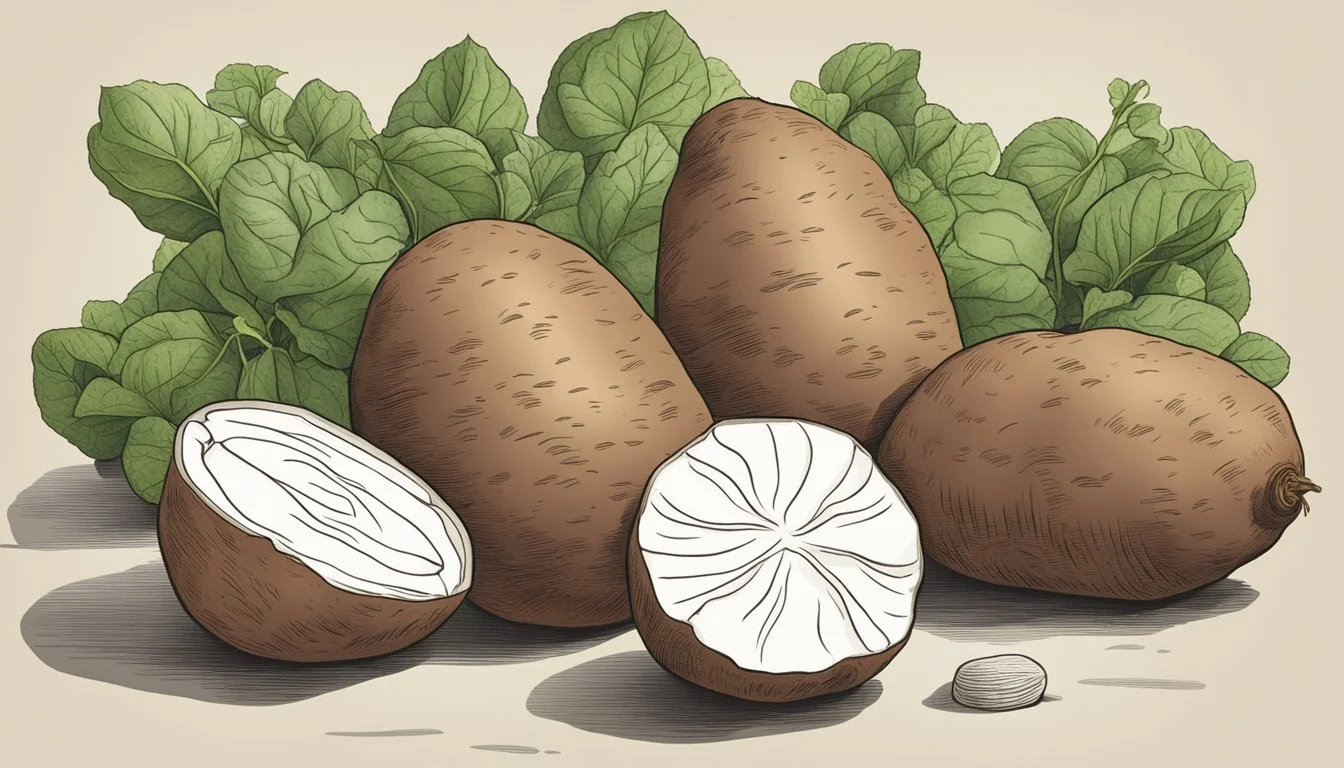Red Potatoes Substitutes
Best Alternatives for Any Recipe
Looking for tasty alternatives to red potatoes that fit a low-carb lifestyle can be a game changer in your kitchen. From versatile vegetables like cauliflower and jicama to unexpected options like red radishes and daikon, there are plenty of substitutes that offer similar textures and flavors without the extra carbohydrates. Cauliflower, with just 2 grams of carbs per 100 grams, has become a staple, often used in place of mashed potatoes or even fried into "rice".
Another fantastic substitute is the red radish, known for its crunch and subtle flavor that can mimic the texture of potatoes in dishes like salads or even roasted sides. Red radishes are lower in carbohydrates and calories, making them a healthier alternative for those aiming to reduce their carb intake.
Daikon radish stands out as well, offering a versatile culinary experience. It can be sliced, diced, or mashed, adapting well to a variety of recipes where you'd typically use red potatoes. With these substitutions, anyone can enjoy their favorite potato-based dishes with a low-carb twist.
Understanding Red Potatoes
Red potatoes are small to medium-sized, round potatoes with a red skin and white flesh.
These potatoes are known for their waxy texture and a lower starch content compared to russet potatoes.
They contain 33.9g of carbohydrates and 3.1g of dietary fiber per serving.
Red potatoes are an excellent source of vitamin C and potassium. Vitamin C helps boost the immune system, while potassium supports heart health and muscle function.
These potatoes have a moderate glycemic index, which means they have a moderate impact on blood sugar levels when compared to high glycemic foods.
Red potatoes also contain valuable antioxidants. These compounds help neutralize free radicals in the body and reduce oxidative stress.
Nutritional Breakdown (Per serving):
Carbohydrates: 33.9 grams
Dietary Fiber: 3.1 grams
Vitamin C: Helps with immunity
Potassium: Important for heart and muscle function
Red potatoes can be used in various dishes such as roasting, boiling, or making salads. Their waxy texture holds up well during cooking, making them a versatile choice in the kitchen.
Popular Red Potato Dishes
Red potatoes are a versatile ingredient that can be used in numerous dishes. Notable recipes include roasted, mashed, and salads, making these potatoes a staple in many kitchens.
Roasted Red Potatoes
Roasted red potatoes are a popular side dish due to their crispy exterior and tender interior. To make this dish, red potatoes are typically washed, cut into wedges, and seasoned with olive oil, salt, pepper, and occasionally herbs like rosemary or thyme. The potatoes are then roasted in an oven at 400°F until they achieve a golden-brown color. This preparation enhances their natural flavors and provides a delightful texture, making them an excellent accompaniment to roasted meats or grilled vegetables.
Mashed Red Potatoes
Mashed red potatoes offer a creamy and chunky alternative to traditional mashed potatoes. The process involves boiling the potatoes until they are tender, then mashing them with ingredients such as butter, milk, and garlic for added flavor. Some cooks prefer to leave the skins on for added texture and nutrients. The result is a rustic, hearty dish that pairs well with gravies and main courses like roasted chicken or beef. Herbs like chives or parsley can be sprinkled on top for an extra burst of flavor and color.
Red Potato Salad
Red potato salad is a favorite at picnics and barbecues due to its light, tangy flavor. The dish typically involves boiling the potatoes until tender, then mixing them with ingredients like mayonnaise, mustard, celery, and onions. For a healthier twist, Greek yogurt can replace mayonnaise. Often, the salad is seasoned with salt, pepper, and fresh herbs such as dill or parsley. Red potato salad stands out for its satisfying texture and the complementary flavors of the dressing and additional vegetables, making it a crowd-pleaser.
Red Potato Soups
Red potato soups are comforting and easy to prepare, featuring a creamy base and the hearty texture of red potatoes. The potatoes are usually diced and cooked in a broth with other vegetables like onions, carrots, and celery. Once tender, the mixture is blended to achieve desired consistency, often enriched with cream or milk for a smooth finish. Bacon bits, cheese, and chives can be added as toppings to elevate the soup. This dish is perfect for colder weather and serves as a wholesome meal on its own or alongside crusty bread.
Low-Carb and Keto Alternatives
For those following a keto or low-carb diet, it's essential to find suitable substitutions for high-carb foods like red potatoes. Fortunately, several vegetables offer a low-carb alternative while maintaining texture and flavor.
Cauliflower as a Substitute
Cauliflower is a versatile and popular low-carb option. It has only 3 grams of net carbs per 100 grams, making it an excellent choice for the keto diet. Mashed cauliflower is a favorite and can provide a similar mouthfeel to mashed potatoes. For a rice-like texture, cauliflower can be riced and used in various dishes, offering a light, fluffy base with low carb content.
Another preparation method is roasting cauliflower. This enhances its natural flavors, providing a savory and satisfying side dish. Cauliflower steaks can also be seasoned and grilled as a hearty alternative to potato-based meals.
Root Vegetable Replacements
Certain root vegetables provide both flavor and a lower carbohydrate content than traditional potatoes. Turnips, for example, have only 3 grams of net carbs per 100 grams. They can be shredded for hash browns, roasted, or boiled, adding flexibility to your keto meal plan.
Daikon radishes and red radishes are also notable. Daikon contains roughly 1.8 grams of net carbs per 100 grams, while red radishes provide a similar low-carb profile. These can be sliced thin for crispy fries, added to soups, or even sautéed, delivering crunch and zest to your dishes.
Kohlrabi offers another alternative with approximately 6-7 grams of carbs per 100 grams. This crisp and juicy vegetable can be roasted, mashed, or used in salads.
Squash Varieties
Squash, particularly butternut squash, provides a sweet and slightly nutty flavor while remaining relatively low in net carbs. Butternut squash has about 12 grams of carbs per 100 grams but the fiber content helps to manage the net carbs.
For a unique twist, spaghetti squash can be used to create a pasta-like texture that pairs well with various sauces and toppings. Roasting or baking spaghetti squash unlocks its potential as a low-carb potato substitute, offering versatility in keto-friendly meal planning.
Zucchini, with only 1.7 grams of net carbs per 100 grams, is another excellent option. It can be spiralized into noodles, stuffed, or grilled as a robust, low-carb base for many dishes.
Nutritious Substitutes for Red Potatoes
Choosing nutritious substitutes for red potatoes can enhance the variety and nutritional content of your meals. Below, explore alternatives that offer unique flavors and nutritional profiles.
Root and Tuber Alternatives
Turnips and rutabagas are excellent substitutes for red potatoes. Both belong to the Brassica family and provide a good source of vitamin C and fiber. When cooked, they have a mild, slightly sweet flavor and a texture similar to potatoes. Daikon radishes, another root vegetable, are crisp and crunchy when raw but mellow and tender when cooked, making them versatile in various dishes. Kohlrabi offers a slightly spicy, turnip-like flavor, and can be boiled, roasted, or mashed. Jicama is also a good choice, providing a crunchy texture and a mildly sweet taste, perfect for salads and slaws.
Legume and Grain Options
While not as common, certain legumes and grains can be effective as low-carb potato substitutes. Chickpeas and lentils can be mashed or pureed to create a texture similar to that of mashed potatoes. They are high in protein, fiber, and essential nutrients like iron and folate. Quinoa, with its nutty flavor and fluffy texture, can replace potatoes in dishes like casseroles and stews. It’s rich in protein and contains all nine essential amino acids. These options provide a unique flavor profile and nutritional benefits that make them worthy potato substitutes.
Non-Starchy Vegetable Varieties
Non-starchy vegetables, such as carrots, parsnips, and celery root, offer nutritious alternatives to red potatoes. Carrots are rich in beta-carotene, which is converted to vitamin A in the body, and they can be roasted, mashed, or used in soups. Parsnips have a sweet, nutty flavor and are high in dietary fiber and potassium. They can be roasted or mashed to provide a hearty texture similar to potatoes. Celery root, also known as celeriac, has a mild, earthy taste and can be boiled, roasted, or pureed, making it a versatile ingredient in many dishes.
By incorporating these substitutes, you can enjoy diverse flavors and textures while enhancing the nutritional value of your meals.
Creative Cooking with Substitutes
When seeking alternatives to red potatoes, the possibilities are endless. Various vegetables can introduce unique flavors and textures to favorite dishes, all while maintaining a low-carb profile.
Alternative Preparations
Substituting red potatoes with vegetables such as cauliflower, zucchini, or turnips can be just as satisfying. One can prepare mashed cauliflower for a creamy side dish. For a roasted version, tossing cubed turnips in olive oil and seasoning them before baking results in a delightful alternative. Zucchini, when sliced thinly and roasted, can mimic the texture of roasted potatoes, providing a nutritious twist.
Daikon radishes also make a surprising stand-in for traditional fries. Cut into sticks, these can be seasoned and baked or fried to perfection. Rutabagas, with their subtle sweetness, can be mashed or roasted, adding depth to a variety of meals.
Innovative Recipes
Exploring new recipes with potato substitutes can enhance any cookbook repertoire. Jicama fries offer a crunchy texture and a refreshing flavor different from typical potato fries. Creating eggplant fritters opens up possibilities for appetizers or side dishes, where the eggplant's soft texture is a delightful change.
Winter squash can be used to create a creamy, rich mash that pairs well with many main dishes. For something more exotic, try mashed yams with a sprinkle of cinnamon and nutmeg. These versatile vegetables can also replace potatoes in traditional recipes such as tater tots or hash browns, delivering both familiarity and novelty in each bite.
Substitutes in Traditional Potato Dishes
Many traditional potato recipes can be successfully made with alternatives. Courgettes (zucchini) work remarkably well in salads, providing a fresh crunch when raw or a tender texture when cooked. Carrots, with their natural sweetness, can be an excellent replacement in dishes like stews or casseroles, adding both color and flavor.
Pasta dishes, such as lasagna, can benefit from slices of eggplant or zucchini as layers, cutting carbs while maintaining richness. Finally, in dishes like potato salad, cooked cauliflower can stand in seamlessly, absorbing flavors just like boiled potatoes would.
These innovative uses of vegetables not only add variety but also support dietary preferences, making traditional potato dishes both healthy and exciting.
Comparing Substitutes
Several vegetables can replace red potatoes in meals, each offering unique taste profiles and nutritional benefits. These substitutes provide options for those looking for low-carb, high-fiber, or lower-calorie alternatives.
Taste Profiles
Radishes come in a variety of colors such as white, pink, purple, and red. They offer a distinct peppery taste that can add a unique flavor to dishes. While their texture is more watery compared to potatoes, they hold up well in cooking.
Cauliflower is another excellent substitute. Its mild flavor allows it to blend seamlessly into recipes, making it a versatile option. When mashed, cauliflower can mimic the texture of mashed potatoes quite well.
Turnips also have a mild flavor and, when roasted, they develop a sweeter taste. They are a low-carb option that fits well in many potato-based recipes.
Daikon radish provides a slightly sweet taste with a hint of spice. It is very low in calories and carbs, making it suitable for those following a low-carb diet. Its high water content means it may require longer cooking times to reduce liquid.
These substitutes not only provide similar textures and flavors but also offer varying nutritional benefits such as increased fiber, vitamin C, and antioxidants, contributing to a healthier diet.
Shopping for Potato Substitutes
When shopping for potato substitutes, the produce aisle offers a variety of options. Some of the most popular alternatives include daikon radish, turnips, zucchini, kohlrabi, eggplant, and carrots.
Daikon radish has a milder, less starchy flavor compared to potatoes. It is crisp and crunchy when raw but becomes tender when cooked.
Turnips have a slightly sweet taste and less starch. They are excellent for roasting, mashing, or adding to stews.
Zucchini can substitute for potatoes in certain recipes. Zucchini fries or roasted zucchini provide a delicious, low-carb alternative.
Kohlrabi offers a unique, slightly sweet flavor and can be roasted, boiled, or mashed.
Eggplant can replace potatoes in recipes like casseroles or as a base for dishes.
Carrots bring a natural sweetness to recipes. They work well in soups, stews, and roasts.
Quick Comparison Table
Substitute Best Uses Texture Daikon Radish Roasting, Soups Crunchy raw, tender cooked Turnips Roasting, Mashing, Stews Slightly sweet, firm Zucchini Fries, Roasting Soft when cooked Kohlrabi Roasting, Mashing Crisp when raw, tender cooked Eggplant Casseroles, Stews Soft when cooked Carrots Soups, Stews, Roasting Crisp raw, tender cooked
Shopping for these substitutes involves examining each for freshness. Look for firm, blemish-free vegetables that feel heavy for their size. By experimenting with different substitutes, one can find the perfect low-carb alternatives to red potatoes.
Engaging with Communities
Engaging with communities is essential for discovering new recipes and tips, especially when looking for red potato substitutes. Platforms like social media and forums provide valuable resources and connect like-minded individuals with shared dietary interests.
Sharing Recipes on Social Media
Social media platforms such as Facebook and Instagram offer robust avenues for sharing and discovering keto recipes and other low-carb diet options. By posting pictures and recipes of innovative potato substitutes like cauliflower mash or zucchini noodles, individuals can inspire and get inspiration.
Sharing step-by-step instructions in video formats or stories is particularly effective. Hashtags like #LowCarbSubstitutes or #RedPotatoAlternatives can help the posts reach a broader audience. Engaging with comments and questions fosters a communal spirit and encourages recipe exchanges.
Joining Food and Diet Forums
Participating in online forums dedicated to food and diets can be incredibly beneficial. Websites like Reddit and dedicated keto forums provide spaces where users discuss low carb substitutes for potatoes and share personal experiences.
Detailed discussions on forums often offer in-depth reviews and tips on using ingredients like daikon radish or jicama as substitutes. Members frequently post meal prep ideas, grocery store finds, and modifications for various recipes, providing a wealth of practical advice. Engaging consistently in these communities can enhance one’s culinary skills and knowledge.








